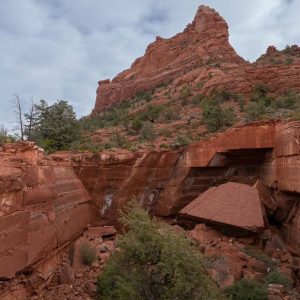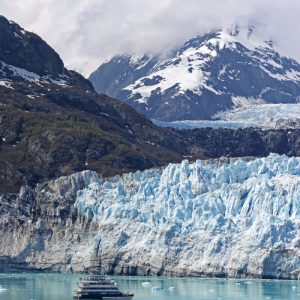Plan a day trip out of Portland Oregon on the Mt. Hood scenic loop. Stop for donuts, play in the snow, return through the Columbia River Gorge.
Volcanic Mount Hood, Oregon’s highest peak, is a must-see when visiting the Portland, Oregon area. You’ll certainly see it when you fly into PDX and on clear days, you’ll see the snowy peak rising from the east from many vantage points in Portland and Vancouver, Washington. But, in a day, you can actually walk on that impressive mountain by taking a day trip to Mt. Hood. The Mt. Hood scenic loop will bring you in touch with mossy forests, entice you to throw a snowball on the mountain, and then return through the shady steep cliffs of the Columbia River Gorge.
Along the Mt. Hood scenic loop you’ll find places to stop for a meal, taste wine, and even pick some lavender. This drive, on one of Oregon’s Scenic Byways, is best done in summer or early fall before the snows return to make driving unpredictable. While there are many ways to drive this loop, this itinerary was always a favorite of my out-of-town guests.
Contents
Views and Famous Donuts in Sandy
You may start and end your beautiful day on I-84. As you head east out of Portland, take an exit in Wood Village to go south and join Hwy 26. Travel Oregon has an interactive map of the Mt. Hood Scenic Byway online.
As you leave the hustle and bustle of the Portland area, you’ll make your way to Sandy. The town is named for the Sandy River, which explorers Lewis and Clark dubbed the “Quicksand River.” Today, the Sandy River, which flows to the Mighty Columbia River, offers recreation and fishing. Before Hwy 26 divides, check out a great viewpoint for your first Mt. Hood photo. Not too far up Bluff Road (you’ll be turning left), you’ll find the Jonsrud Viewpoint that looks across the Sandy River Valley where the pioneers made their way west to “Eden.” Mt. Hood is the centerpiece of this view.
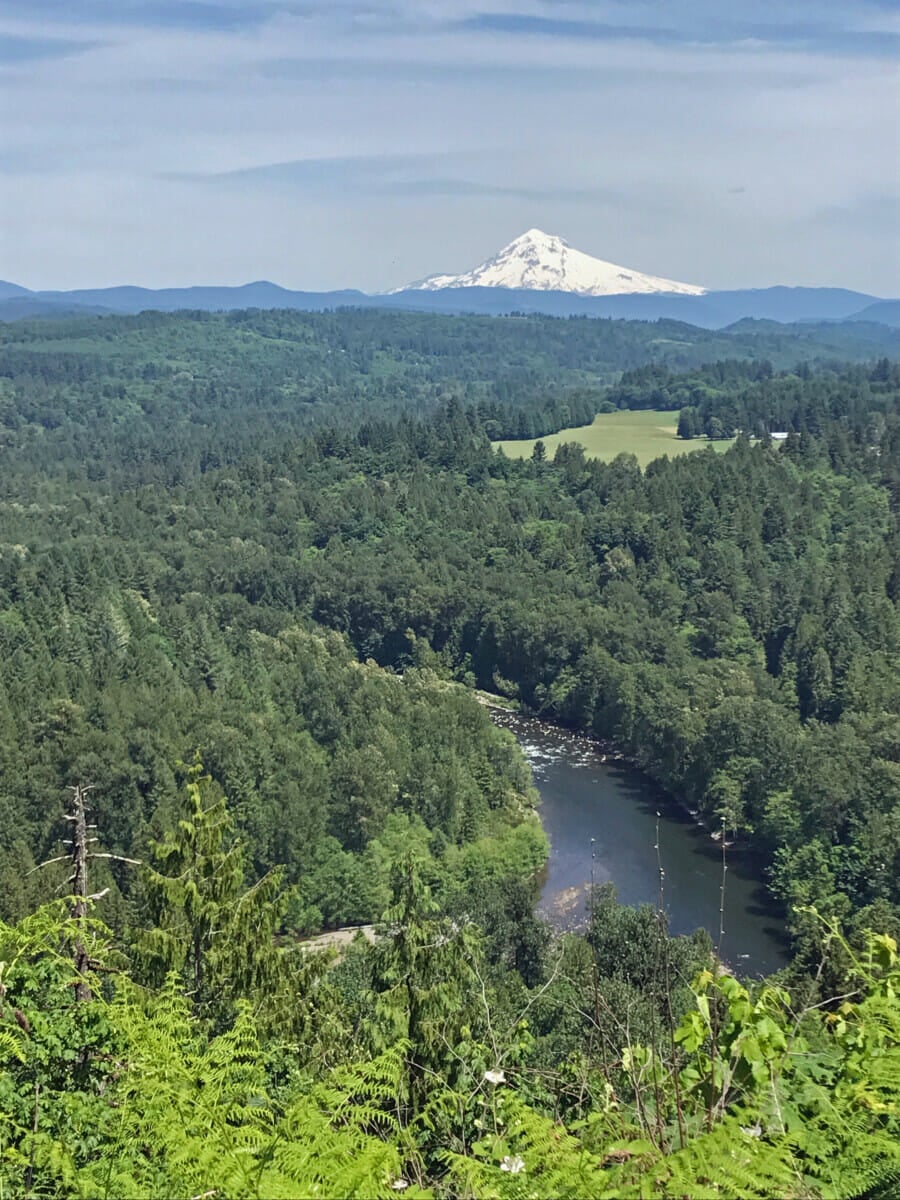
Stop to take in the view of Mt. Hood. Photo by Elizabeth R Rose
You’ll probably be hungry or craving a cup of coffee, so the next stop off Hwy 26 is for donuts! You can’t miss Joe’s Donut Shop in the red and white block building. It’s small, but since 1976 Joe has been hand-making donuts so delicious that the shop has developed a cult following. It’s a tradition to stop for a donut on the way to the mountain. They have simple donuts but try the apple fritters, the maple bars, or a breakfast sandwich. Don’t forget the coffee, too. Joe’s Donut Shop is open 4 am – 5 pm Monday through Friday, and 5 am – 5 pm on Saturdays and Sundays. It’s usually also open on holidays!
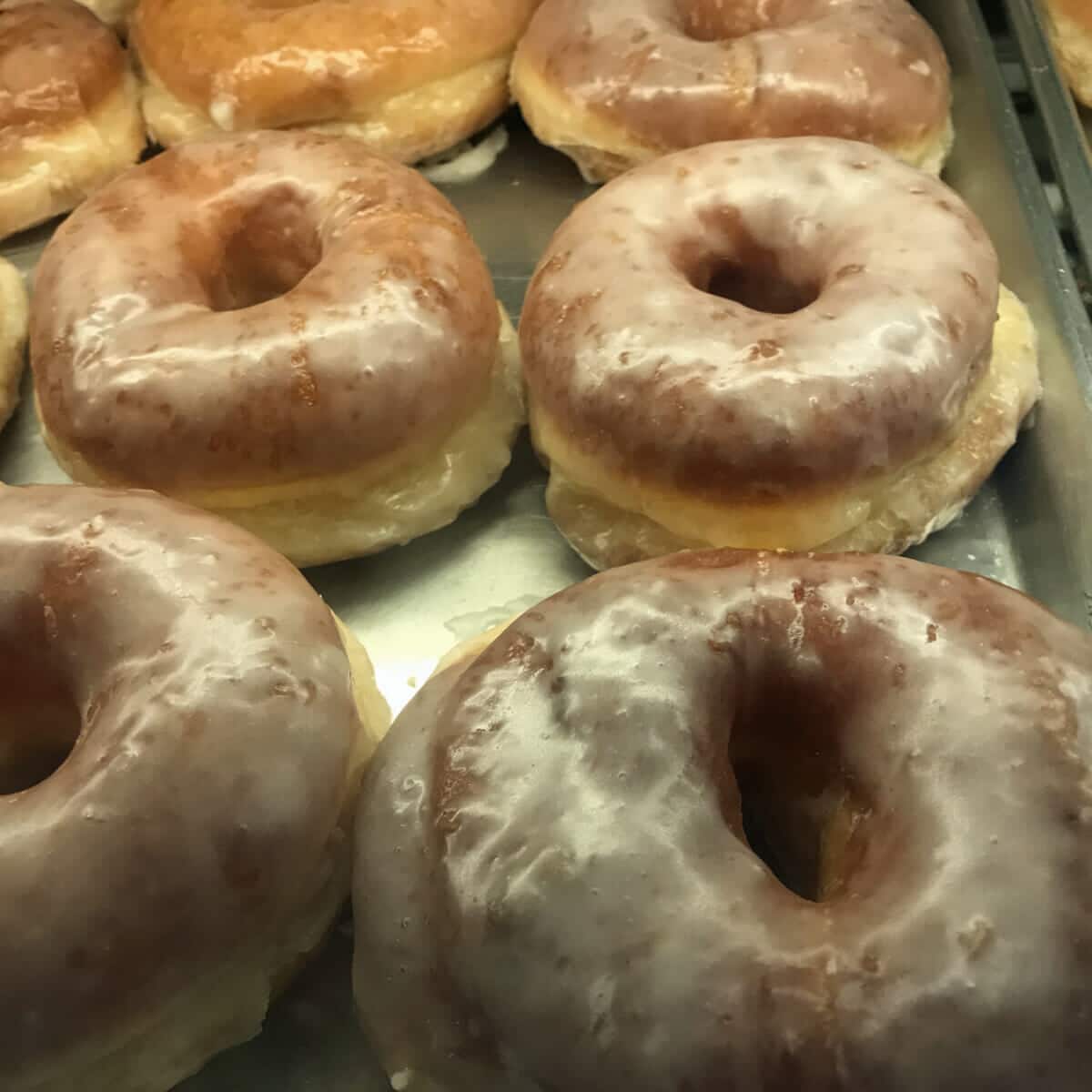
Stop in Sandy to fuel up with gas for the car and Joe’s Donuts to fortify you for your drive up the mountain. Photo by Elizabeth R Rose
Wander Wildwood
Sufficiently fueled, you’ll be driving into the wooded foothills of Mt. Hood, through quaint mountain villages like Rhododendron, Zig Zag, and Welches. You’ll find the Wildwood Recreation Area just past Welches on your right. This is a favorite place to stop to admire the moss-laden trees and wander trails along the river. You can take a long hike or wander paved trails with boardwalks over the wetlands. I especially like seeing the green life springing from decaying logs (called “nurse logs”) on the forest floor.
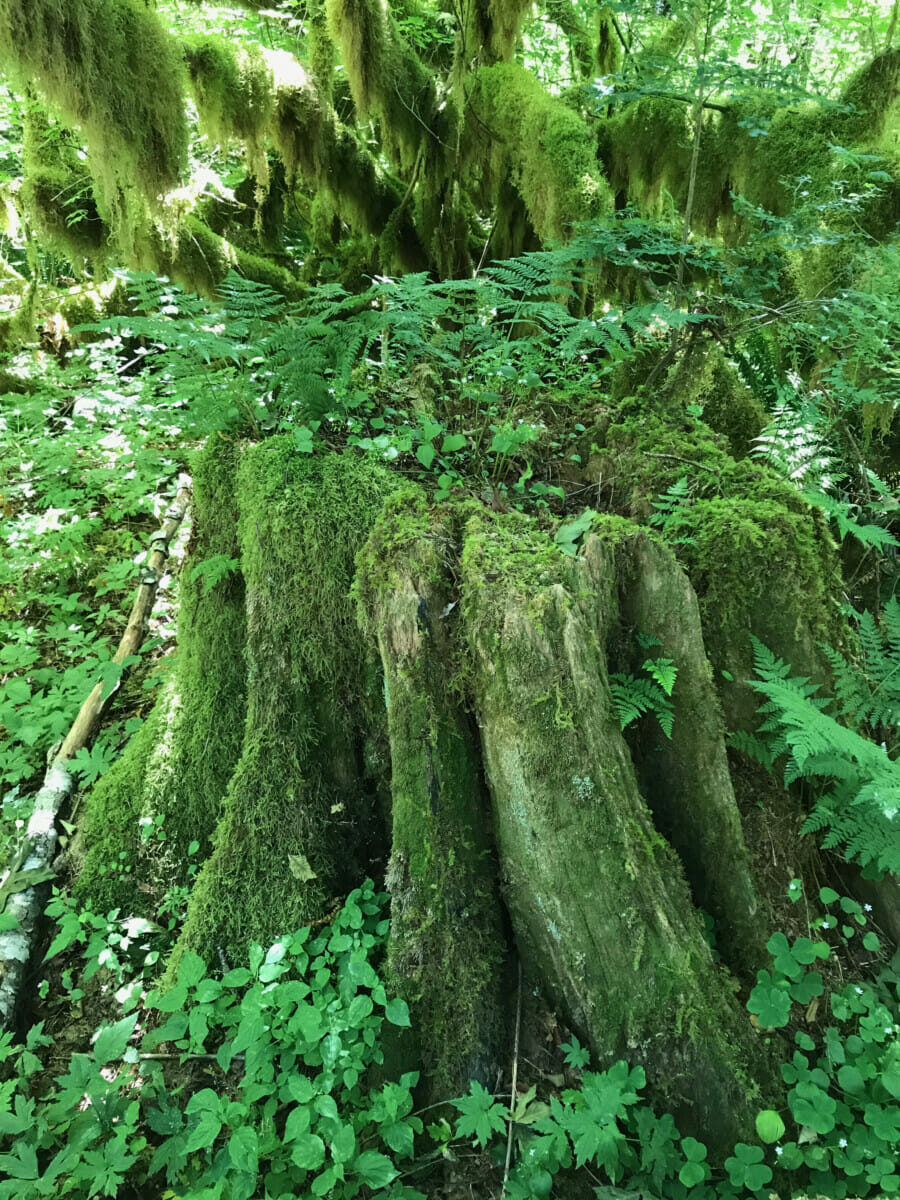
Stumps and logs are full of new life on the forest floor. Photo by Elizabeth R Rose
Be sure to look for fish at the Cascade Streamwatch window built into the riverbank giving you a great view of underwater life. If you haven’t devoured your donuts by now, there are pretty places to rest and have a snack. Some of the benches have been carved with fish designs by a local artist.

Along the streamside path, there were art installations and carved benches. Photo by Elizabeth R Rose
You can purchase a $5.00 vehicle day pass online or at the kiosk at the entrance to this BLM property.
After a great stop to enjoy the beauty of the forest, you’ll be headed up the mountain to Government Camp, where you’ll find the rest areas. Continue on Hwy 26, turning left on Timberline Road to enjoy the view of the mountain as you approach the historic lodge. Park in one of the day-use parking lots and walk up to the lodge. You’ll be at 6,000 feet of elevation so take it easy!

As you drive up Timberline Road, you’ll want to stop for a photo with the mountain. Photo courtesy Geoffrey M Nelson
Take in Historic Timberline
Wandering the halls, looking at the displays of how Timberline Lodge was built incorporating the handiwork of area residents during the Great Depression, and stopping to rest in the lobby to gaze up at the massive stone fireplaces are things you’ll want to do on the most important stop on the Mt. Hood scenic loop. Timberline was built, in part, using workers and funding from two important Depression-era social programs—the Works Progress Administration (WPA) and Civilian Conservation Corps (CCC).
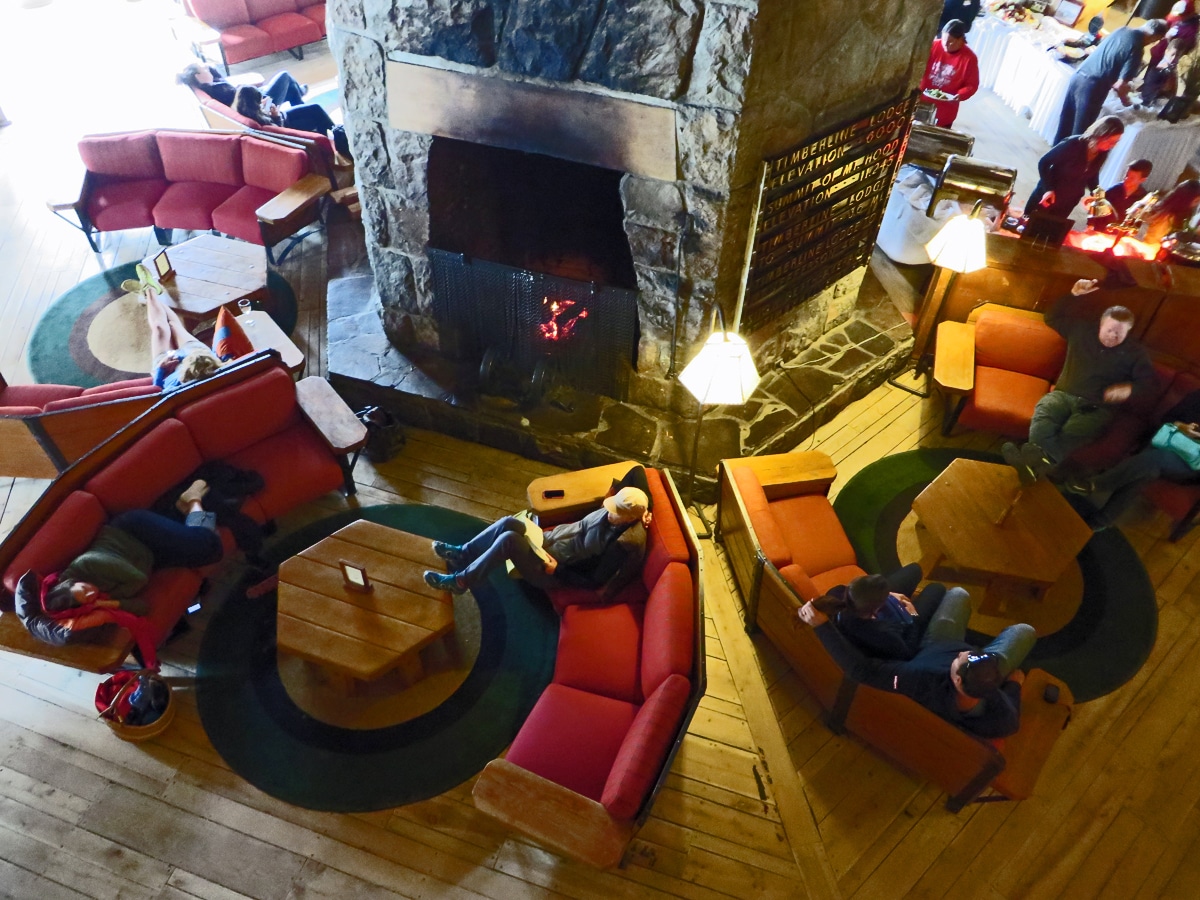
Relax around the massive fireplace at Timberline. Photo by: Elizabeth R Rose
Opened in 1938 and declared a National Historic Landmark in 1977, Timberline Lodge is recognized by many as one of the best examples of “Parkitect” Gilbert Stanley Underwood’s rustic National Park lodges. Underwood also designed Bryce Canyon Lodge, Zion Lodge, and Yosemite’s Ahwahnee Lodge. The style incorporates massive elements such as logs and large river rocks, all sourced locally.
Note: The areas around Mt. Hood make up the Mt. Hood National Forest. Although it was favored to gain national park status in the 1940s, that never happened. So, although Mt. Hood is not a national park, Timberline Lodge is an excellent example of Underwood’s design in many National Park lodges across the country.
Catch the Details of Timberline Lodge
I urge visitors to walk through the lodge slowly and look for small elements such as animals carved into the posts of stair banisters and ram’s heads forged into wrought ironwork. Even the furniture, made from heavy local wood, is part of the “lodge look.” As additional architects and artisans worked on plans for the lodge, the lodge took on a more refined look with touches from the city below, Portland. The style is now called “Cascadian,” named after the mountain chain, but, to me, Timberline Lodge retains the rustic look originally proposed by Underwood, which draws me to it.
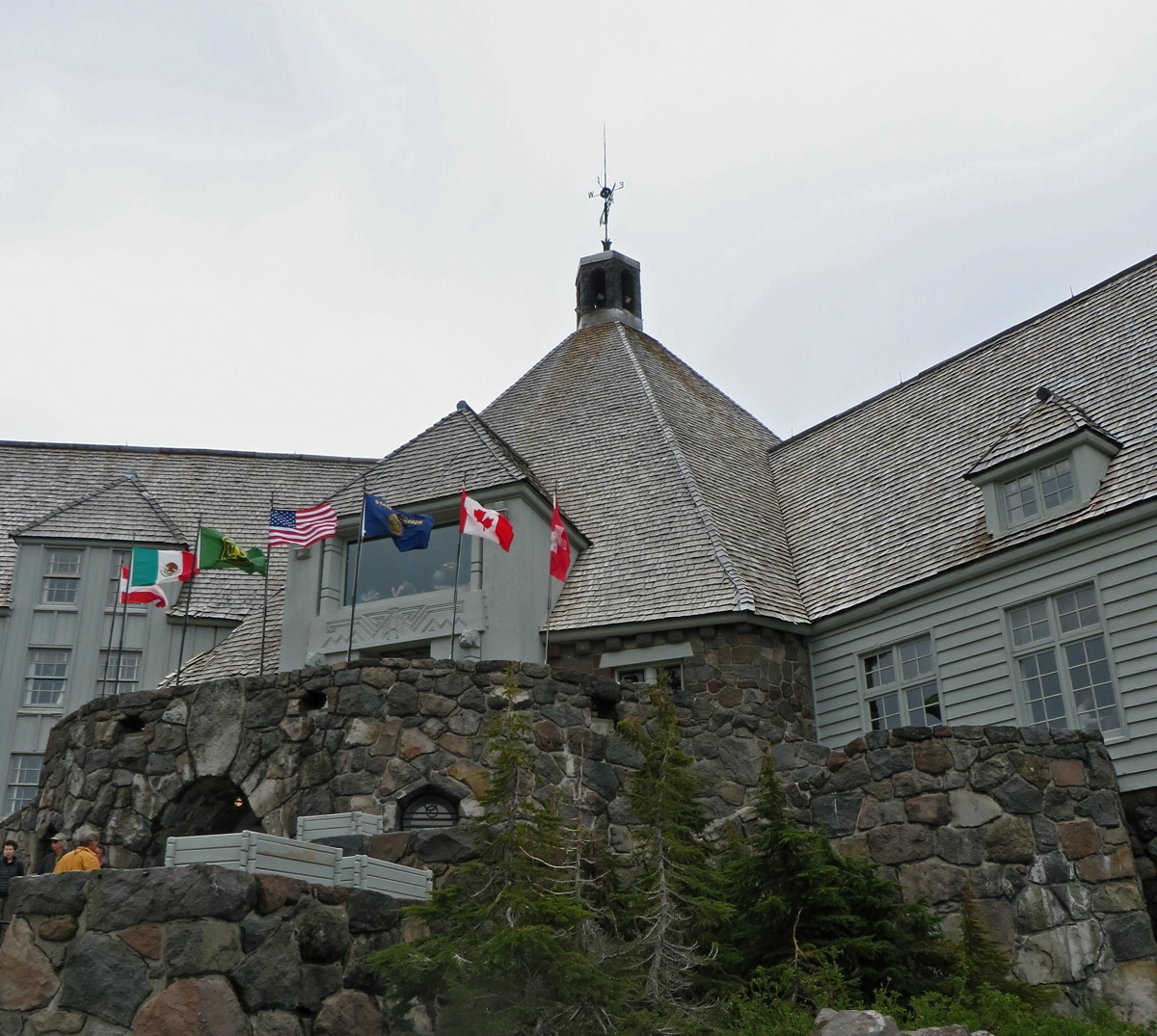
Timberline Lodge is one of the grand lodges of the Pacific Northwest. Photo by: Elizabeth R Rose
The interior décor includes hand-woven curtains, stained glass work (peek into the Blue Ox Bar), massive mosaics, wood carving incorporating Native American and pioneer themes, and the ever-present wrought ironwork. It’s like a museum where the elements surround the visitor instead of being placed behind glass in a display case.
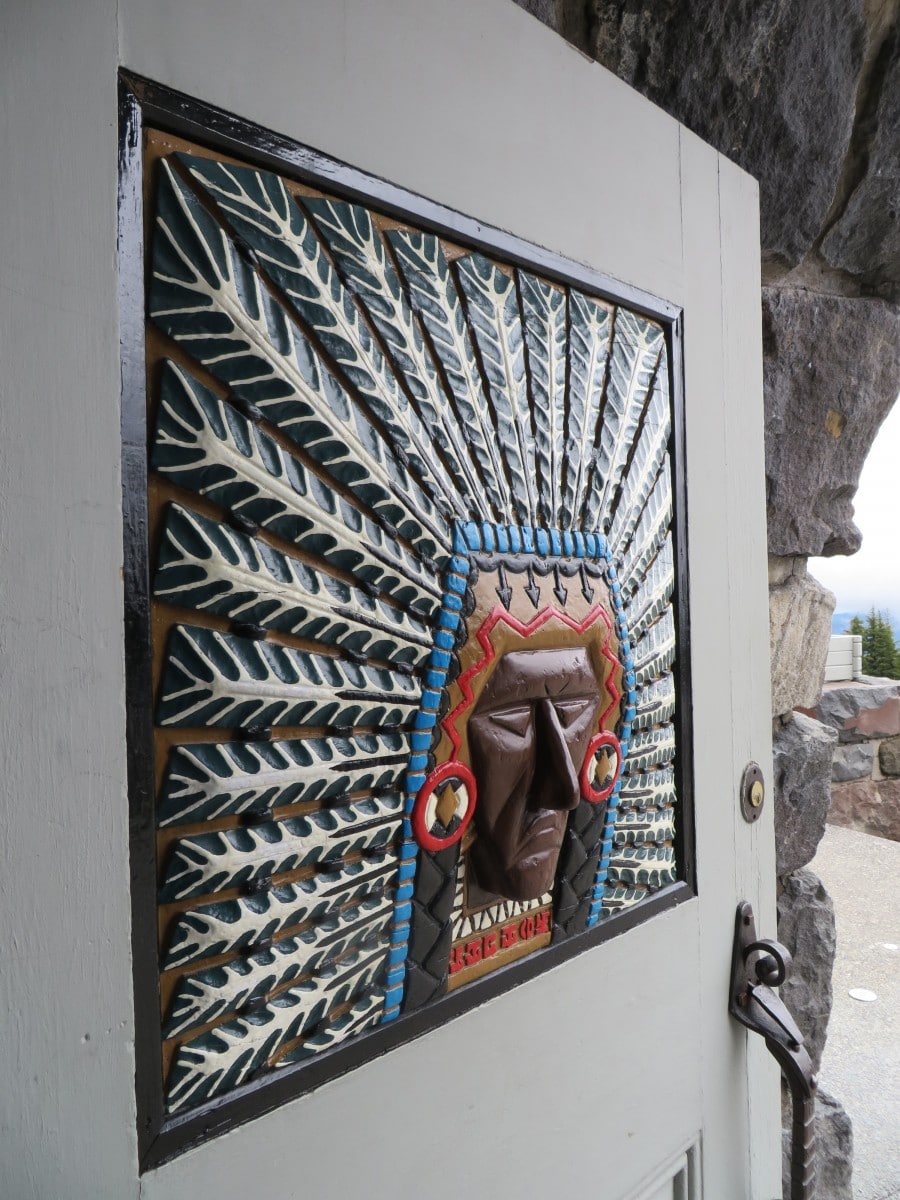
There is interesting hand-carved and ironwork detail at every turn. Photo by: Elizabeth R Rose
The Ranger-led tours are well worth your time if you are there when they are being offered. Inquire at the ranger desk on the lower level. Another option is to stop at the Lodge’s Barlow Room, where you can watch a 30-minute video presentation of The Builders of Timberline.

My granddaughter stopped at the Forest Ranger desk to get her National Park Passport stamped and we found out about the free Ranger-led tours. Photo by: Elizabeth R Rose
Dining at Timberline Lodge
Timberline’s Cascadia Dining Room (reservations recommended) is known for bountiful buffets and lovely dinners incorporating local Pacific Northwest ingredients. It’s a fine dining option where you can still wear casual hiking clothes. Other options include casual dining upstairs at the Ram’s Head Pub and fast food across the way at the Wy’East Day Lodge.
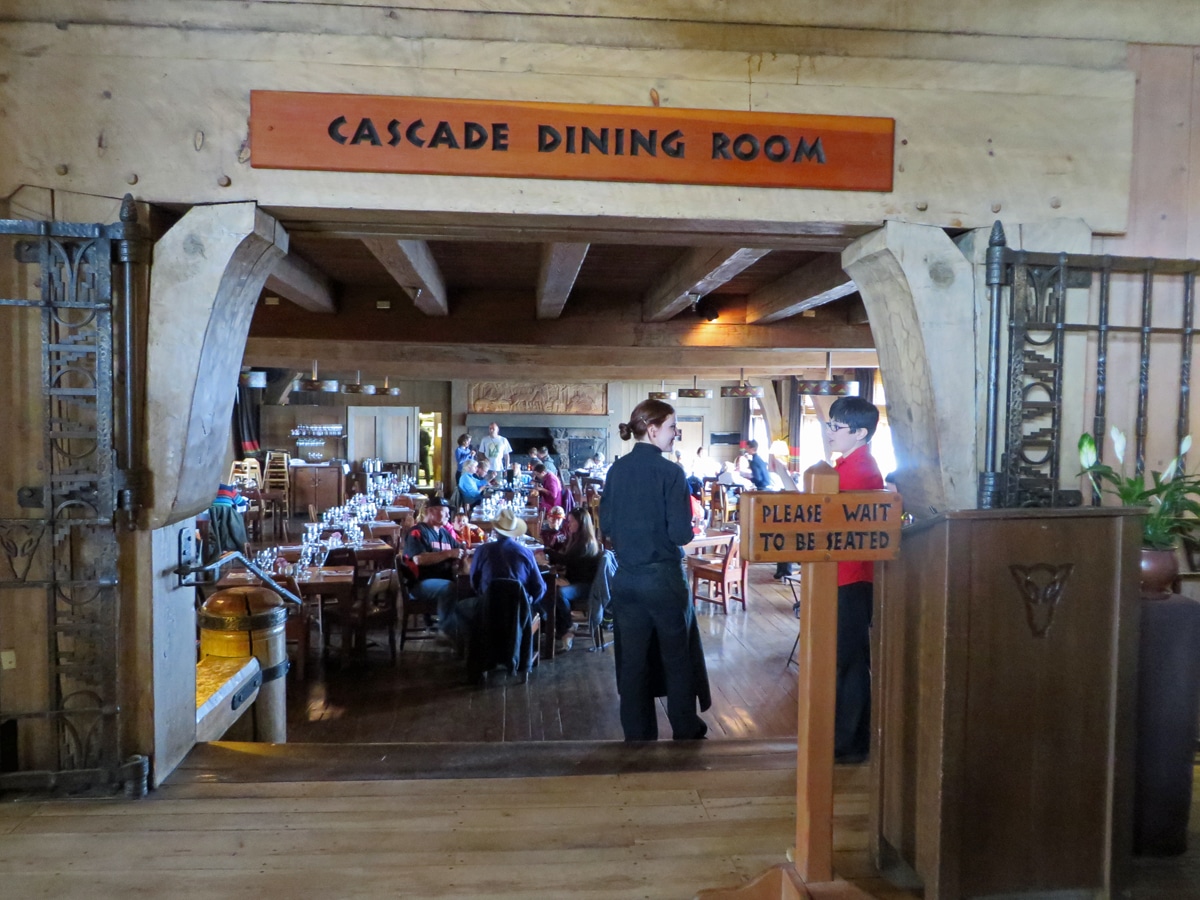
Cascade Dining Room at Timberline Lodge. Photo by Elizabeth R Rose
Summer Snow on the Mt. Hood Scenic Loop
For my family, who visited from Florida, Mt. Hood’s snow (even in July) was the attraction. While the kids watched snowboarders come off the mountain after a morning of shredding the powder, they were thrilled to toss snowballs and feel the crunch of the snow beneath their boots. Timberline is the only ski area in North America opens all 12 months of the year.
The winter season typically begins early to mid-November and continues through Memorial Day. Their Palmer Express high-speed quad lift allows them to operate later into the summer season than anyone else (usually June 1st through Labor Day). But this was a day trip and we had much to see, so we settled for a walk up to the snowpack from the lodge and some fun throwing snowballs.
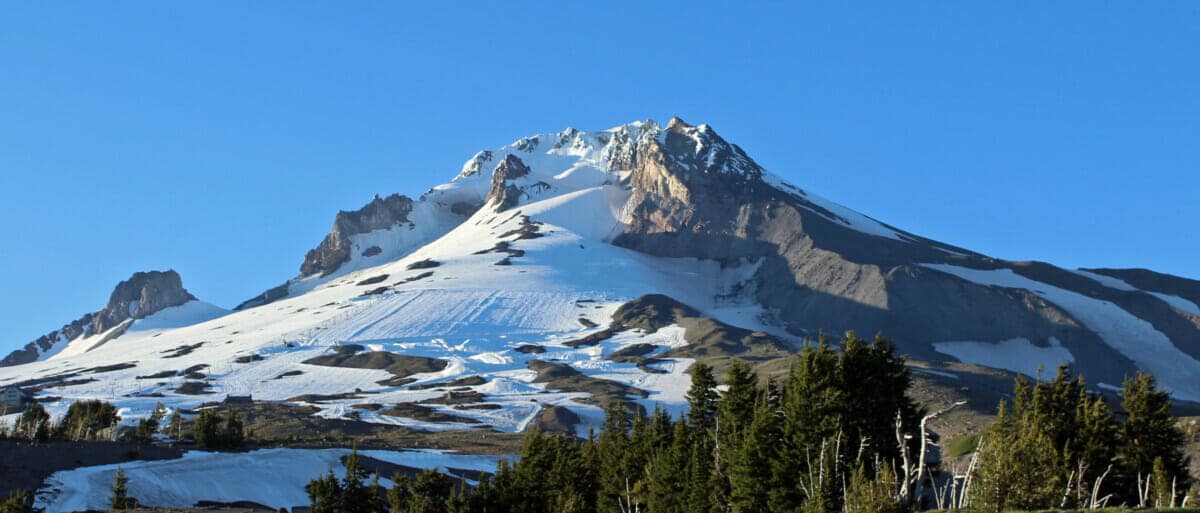
When you get to the edge of the snowpack, you can throw snowballs and look up at the ski lifts. You are on the mountain! Photo by Elizabeth R Rose
Revel in Lavender
After enjoying all that Timberline had to offer, it’s time to leave Hwy 26 and drive Hwy 35 on the “backside” of the mountain. This takes you through the Mt. Hood National Forest with sights such as Tamanawas Falls accessible by a trail along Cold Spring Creek. As you head down into the valley, look back and catch glimpses of Mt. Hood.
Once you reach the beautiful Hood River Valley with its orchards and fields, a popular stop is the Hood River Lavender Farm where you can enjoy mountain views, endless rows of purple lavender, and have a chance to purchase lavender products. Pick your own lavender from the field and enjoy the aroma as you drive home.

Majestic Mt. Hood looks over the Hood River lavender fields. Photo by Elizabeth R Rose
Sip Wine with a Mountain View
Since this is all about Mt. Hood, how about a stop at Mt. Hood Winery. The wines are iconic for Mt. Hood on the label. The winery offers a magnificent view of the mountain. As they say, “Come for the wine and stay for the views.” Mt. Hood Winery’s award-winning wines are grown in the Mt. Hood area volcanic soil.
While the contemporary tasting room is newer, the Bickford family has been growing orchard fruit in the Hood River Valley for generations. In 2000, they were talked into growing grapes and making wine and the business has taken off. I took a tour of their facility and ran into a winemaker who just happened to own another winery where I had tasted. He was one of their expert winemakers. Among the wine growers and producers, there is camaraderie. I was told that they all have lunch together every Friday and drink other people’s wine.

Enjoy a tasting with a view of Mt. Hood at the Mt. Hood Winery. Photo by Elizabeth R Rose
After tasting wine (including the pear wine from the family’s orchard), we took a glass of Pinot Noir outside to sit in an Adirondack chair and marvel at the mountain. Soon, the Mt. Hood scenic loop tour would take us into the shadows of the magnificent Columbia Gorge, and views of Mt. Hood would be just memories.
Returning Through the Columbia River Gorge
While you can stop in Hood River for pizza at a place like Solstice, if you are touring with kids, sometimes it’s just fun to head back into the Portland area, making a few stops in the Columbia River Gorge. You’ll be once again on I-84, this time heading west. Watch for huge barges that ply the river, marvel at the high cliffs, and watch for waterfalls.
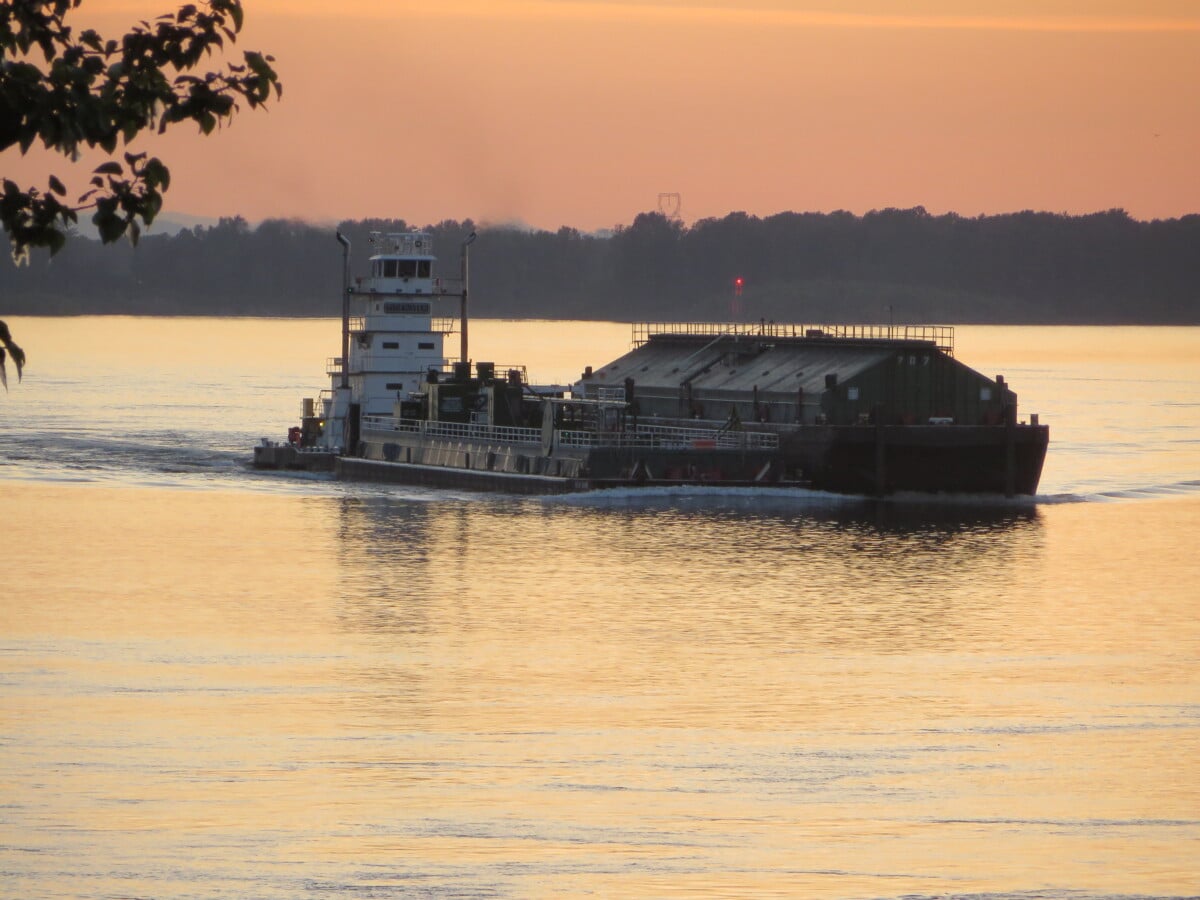
After a long day driving around Mt. Hood, enjoy the sunset along the Columbia River as you make your way to Portland. Photo by Elizabeth R Rose
While it’s too crowded at Multnomah Falls by that time of day, you can still have a peek at it as you pass this amazing double falls on your left. Soon you will be back in town laden with bouquets of lavender, a few bottles of Hood River Wine, souvenirs from Timberline Lodge, and amazing memories of the day spent on the Mt. Hood scenic loop.
